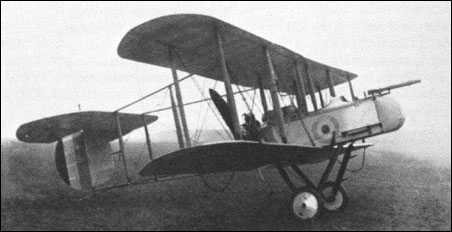|
| Progressive changes introduced by successive E.F.B.3s led to the E.F.B.5 - the E.F.B.4 being a project with a more streamlined nacelle centred between the wings and only two tailbooms - which was flown from Joyce Green to Brooklands on 17 July 1914. In parallel, Vickers developed the E.F.B.6, which, basically similar to the E.F.B.5, had longer-span upper wings. It lacked top decking between the two crew seats and had ailerons in the upper wings only. At Brooklands on 14 July 1914, the E.F.B.6 was taken on strength by the Royal Flying Corps when World War I began, but was not developed. The E.F.B.5, on the contrary, was ordered into production for both the RFC and the RNAS on 14 August 1914, the first series aircraft being completed in the following October. At this time, the aircraft became simply F.B. (Fighting Biplane) 5 and was dubbed Gunbus. The E.F.B.5 had retained the semi-circular tail-plane of the E.F.B.2 and early E.F.B.3, but the series F.B.5 had an enlarged tailplane of rectangular planform and a larger rudder. A Lewis gun on a more practical mount supplanted the similar-calibre Vickers in the nose and the standard power plant was the 100hp Gnome Monosoupape nine-cylinder rotary. The first F.B.5 reached the Western Front early February 1915, and, on the following 25 July, the first squadron of any air service formed specifically for fighting duties and equipped throughout with a single aircraft type arrived in France, this being the RFC's No 11 Sqn with F.B.5s.
The RNAS made little use of the F.B.5, and, after the delivery of four to that service, the large majority of subsequent deliveries went to the RFC, although the RNAS did receive two further F.B.5s which, ordered in May 1915, were fitted with the 150hp Smith Static radial engine, its large diameter propeller necessitating the raising of the fuselage nacelle several inches above the lower wing. Two hundred and forty-one F.B.5s were delivered to the RFC, of which 109 were sent to the British Expeditionary Force in France (60 in 1915 and 49 in 1916). Licence production of the F.B.5 was undertaken in France by the Societe Anonym Darracq (which built a total of 99 of these and the later F.B.9) between May 1915 and June 1916. Twelve were also built under licence in Denmark in 1917-18 by the Tojhusvasrksted. At least four F.B.5As were built with armour-plated fuselage nacelles and these were powered by 110hp Clerget 9Z nine-cylinder rotary engines and had oleo undercarriages. Suffering an unreliable engine and a marginal performance throughout its operational career, the F.B.5 was finally withdrawn from the Western Front in the autumn of 1916, being subsequently confined to RFC instructional units.
 | A three-view drawing (1278 x 906) |
| WEIGHTS |
| Take-off weight | 930 kg | 2050 lb |
| Empty weight | 553 kg | 1219 lb |
| DIMENSIONS |
| Wingspan | 11.13 m | 37 ft 6 in |
| Length | 8.28 m | 27 ft 2 in |
| Height | 3.38 m | 11 ft 1 in |
| Wing area | 35.49 m2 | 382.01 sq ft |
| PERFORMANCE |
| Max. speed | 113 km/h | 70 mph |
| Range | 402 km | 250 miles |
| Chris Whitworth, e-mail, 17.03.2015 21:03 Whitworth -I was a student at Brooklands Tech in the late 60's. We often went onto the BAC site. I once had a flight in the Gunbus replica, and worked on the engine briefly. I believe the Pilot was "Trubshaw" who also flew in Concorde? reply | | Justin, e-mail, 09.01.2012 16:52 Boobies are sweet reply | | Justin, e-mail, 09.01.2012 16:51 This plane was the best of its time it helped us win world war 1 so do be hatein reply | | bingshuya, 20.06.2011 13:55 I am researching building the nacelle Best Regards reply | |
| | Barry, 22.09.2009 17:10 The top photo is an FB9. reply | | Ace, e-mail, 27.12.2008 08:21 this plane could be vulerable.
my advice is you dont fly this reply | | Hugh Gemmell, e-mail, 16.03.2008 03:06 Who would be holding the drawings for this A /C ? I am researching building the nacelle Best Regards reply |
|
Do you have any comments?
|
| 
COMPANY
PROFILE
All the World's Rotorcraft
|








